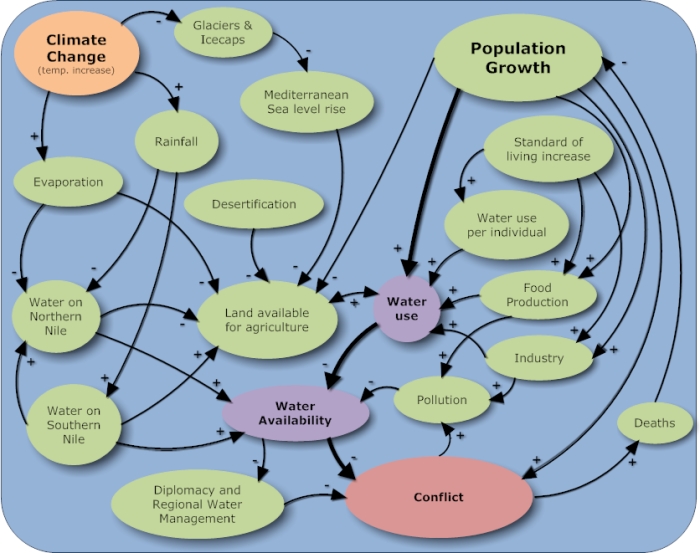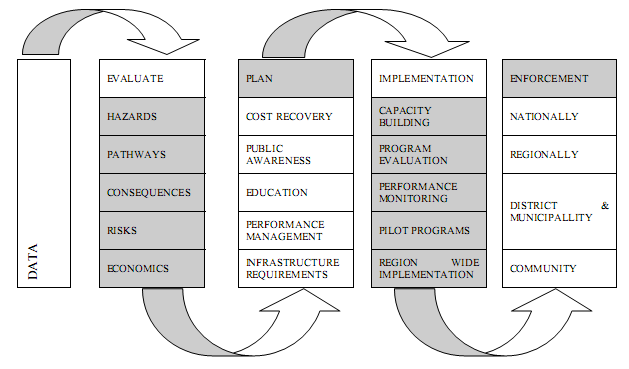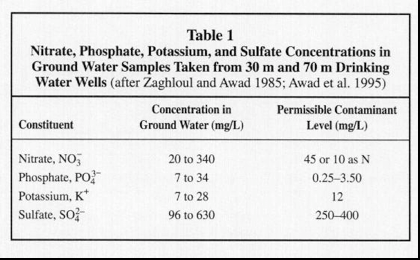Description of river Nile
River Nile is the largest river in the world. River Nile covers a total distance of 6,625 kilometers and runs through the Sahara desert. Lake Victoria is considered the primary source of River Nile. Other secondary water catchments areas of river Nile include the Ethiopia, Eritrea, Kenya, Uganda, Sudan, and Egypt. River Nile discharges its water into Mediterranean Sea.
Concerns for pollution of river Nile
The length of river Nile whose economic activities contribute into pollution covers a distance of 1, 350 kilometers downstream from Aswan High Dam. The distance between Aswan High Dam and the River Nile Delta is lined with over seven hundred industries that drain their waste products into the river. Dumont (pp.2-6) claims river Nile basin pollution is a matter of environmental, agricultural, industrial and household concern.
In addition, Yanful (pp.12-26) argues that the problem of pollution has been brought about by increasing pressure on land subject to increasing population growth and increasing demand for fresh water (figure 1). As a result Oil Spill Intelligence Report suggests that pollution along the River Nile basin continues to threaten biodiversity hence its primary impacts on economy and quality of life need to be strategically managed in order to achieve sustainability of River Nile ecosystem and balance of nature.
Current concerns on river Nile and River Nile basin
Industries that have been set up along the river Nile have contributed greatly to increasing water and soil pollution that has elevated land degradation and loss of soil fertility. Projections of baseline data on Nitrate, Phosphate, Potassium and Sulfate concentration in ground water samples demonstrates that ionic concentration has been increasing and provides primary source of water pollution (table 1). Soil and water pollution (Dumont, pp.12-19) have been cited as primary contributors to pollution of River Nile.
Industrial disposal of waste products on river Nile predisposes eutrophication and algal bloom that negatively affects Biological Oxygen Demand (BOD) hence contributing into secondary effects like decrease of aquatic life like fish along the river Nile. Decrease of fish levels predisposes a tertiary cause to water pollution through fishermen use of unsafe fishing methods.
The main pollutants are agrochemicals, heavy metals disposed from manufacturing industries and human waste disposal into river Nile. The projections of increase of population along the river Nile relative to number of sewer treatment facilities demonstrates that the problem of sewage, and disposal is likely to rise and have negatively impacts on sustainability of river rile to support ecosystem, economic activities, industrial operations and meet demand for human consumption (figure 1, table 2)
Strategies for management and protection of river Nile from pollution
The rationale for control and protection of river Nile from pollution should be structured on the cause of the pollution (Miller, Owino, Vasagar) and capacity to implement holistic approaches in pollution control and management.
Agricultural perspective towards control and prevention of pollution
Protection of river Nile from pollution should be structured towards minimizing impacts of agricultural pollutants (Miller, Owino, Vasagar) through increased reduction of agricultural surface runoff into canals that empty their water into river Nile. Surface run-off from agricultural sector increases fertility of water leading into eutrophication and biotic pollution. The surface runoff consists of soluble fertilizer-based salts namely nitrogenous, potassium, phosphate and sulfate (table 1). Pesticides and herbicides application runoff increase organic and inorganic chemical composition of the water and soil. Organic farming should be adopted which could result into reduction of use of herbicides and pesticides (Miller, pp.56-64).
Strategies for managing industrial pollutants
The industries should set up facilities for proper treatment of waste products in order to ensure the waste products that are finally released into the environment do not harm the environment, or cause long term negative effects on biodiversity and ecosystem (Yanful, pp.25-34). The industries should further improve on their technological efficiencies in order to improve on productivity performance hence reduce production and accumulation of waste products.
The protection of river Nile and river Nile basin should be based on implementation of cleaner production1. Cleaner production has capability to reduce environmental, industrial and agricultural impacts and ensures pollution prevention and control is implemented at the source of pollution (Miller, Owino, Vasagar). Cleaner production has ability to contribute into management of product (domestic refuse, industrial refuse, industrial waste or fertilizers) across its lifecycle so that it has no negative impacts on the ecosystem (Kirkwood & Longley, pp.21-24). Community education of waste management should be carried out. The capability to protect river Nile requires external financing if the benefits of water and soil pollution could be attained.
Strategies for managing fish scarcity along the river Nile basin
The impacts on eutrophication that arises from deposition of surface run-off from agriculture and sewage disposal into river Nile have reduced dissolved oxygen in river Nile and stimulated death of aquatic life (Gawad). This has reduced population of fish. Since fish forms part of staple food for inhabitants along river Nile basin, the fishermen have resorted into use of inappropriate fishing techniques for instance use of bombs, gas or electricity in fishing which further increases pollution.
Recommendations
Protection of river Nile from pollution requires an integrated approach that should be structured towards quality water management. There should be development of policies and water management practices that should contribute into achievement of minimal level of contamination that could not affect quality of life along the river Nile basin (Jabbra et al, pp.7-12). The capacity to achieve and implement policies on water management however demands cooperation between different stakeholders, policy analysts, planner and the communities.
The stakeholders should design a common strategy, modify existing polices and structures on water management and demonstrate capacity to monitor and verify consequences of actions that would be proposed as appropriate for water management (Fishar & Williams, pp.67-69). The personnel responsible for managing change with regard to water quality management should demonstrate flexibility in implementation of policy changes and adopt best practices that could benefit all stakeholders (Gawad). This should depend or follow a structured integrated approach to water pollution control (figure 2)
References
Dumont, Henri J. The Nile: Origins, Environments, Limnology and Human Use. New York: Springer Science and Business Media, 2009.
Fishar, Reda and Williams, Peter W. The Development of a Biotic Pollution Index for the River Nile in Egypt. New York: Springer Science and Business Media, 2007.
Gawad, Abd S. “The Mollusk Gastropod Lanistes carinatus (Olivier, 1804) as Abiomonitor for Some Trace Metals in the Nile River.” International Journal of Zoological Research, 5.3, (2009).
“Index to 2010 Issues of Oil Spill Intelligence Report.” Oil Spill Intelligence Report, 34:2, (2010).
Jabbra, Joseph G. et al. Governmental Response to Environmental Challenges in Global Perspective. Amsterdam: IOS Press, 1998.
Kirkwood, Ralph C. and Longley, Anita J. Clean Technology and the Environment. New York: Blackle Academic and Professional, 1995.
Miller, Alexandra. Historical Treaties Cause Modern Dispute in Negotiations over Nile Water Distribution. The Guilfordian, 2010.
Owino, Arthur O. THE NILE TREATY. Nairobi: Konrad Adenauer Foundation, 2004.
Vasagar, Jeevan. Nile Water Agreement. London: Guardian, 2004.
Yanful, Ernest K. Appropriate Technologies for Environmental Protection in the Developing World. New York: Springer Science and Business Media, 2009.
Appendix




Source: Adapted from Jabbra, Joseph G. et al. Governmental Response to Environmental Challenges in Global Perspective. Amsterdam: IOS Press, 1998.
Footnotes
Kirkwood and Longley, p.27 defines cleaner production as “the continuous application of an integrated preventive environmental strategy to processes, products and services to increase efficiency and reduce risks to humans and the environment”.